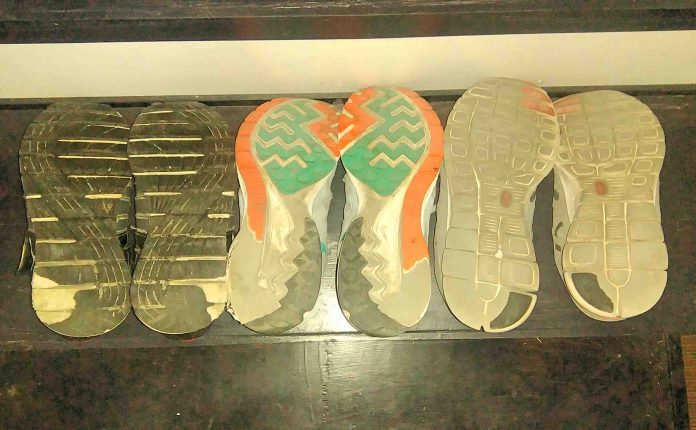I hate having to buy a new pair of running shoes. There’s so much pressure to buy the right kind lest I a. suffer an injury or b. waste money. After all, running shoes are not that cheap. And it’s going to be costly treating an injury, too.
Since I signed up for a marathon in December 2016 and due to race in March 2017, this also means I have to get a new pair soon so I can break them in before 4 to 6 weeks before race day.
There’s no denying my old pairs are begging to be retired. The soles and frayed mesh tops attest to that and I guess they have given me years (a couple or more) of “good service.”
According to Running Competitor, most running shoes will last between 482 – 800km while minimalist shoes are somewhere between 321-643km because they have less material.
But then again, Born to Run author Chris McDougall contends it’s not about the shoes but how we run that really matters. That if we run gently, we can wear – or not wear – anything we please. More about that here
Anyway, if you do engage in shoe buying and if you’re an underpronator like me, I found this advice from this website:
1. Choose shoes with a lot of cushioning and shock absorption;
2. A lightweight, flexible midsole;
3. Arch support
The site also tells me that I should stay away from motion control or stability shoes.
Also, I took a shoe advisor test on Runners World and basically got the same recommendation: Plenty of cushioning but still flexible.
To take the test, click here.
So these are the two most important criteria when choosing a supinator’s shoe. Because supinators have different types of arches, we’ll just have to try shoes on whether they provide the right arch support for our feet.
Now we have a clearer picture of what we need. Know your feet, know your need and you’ll have a better experience shoe shopping. Plus, we won’t be suckered into buying the most expensive shoes on the rack 🙂
What is supination, anyway?
Supination (or under-pronation) is the opposite of pronation and refers to the outward roll of the foot during normal motion. A natural amount of supination occurs during the push-off phase of the running gait as the heel lifts off the ground and the forefoot and toes are used to propel the body forward. However, excessive supination (outward rolling) places a large strain on the muscles and tendons that stabilize the ankle, and can lead to the ankle rolling completely over, resulting in an ankle sprain or total ligament rupture. http://stretchcoach.com/articles/pronation-supination/


